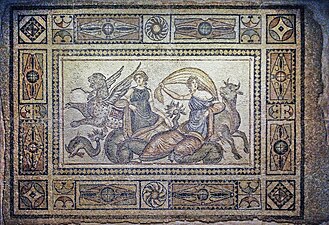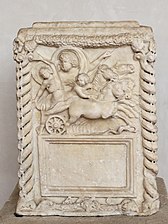
Velificatio is a stylistic device used in ancient Roman art to frame a deity by means of a billowing garment. It represents "vigorous movement," an epiphany, or "the vault of heaven," often appearing with celestial, weather, or sea deities. It is characteristic of the iconography of the Aurae, the Breezes personified, and one of the elements which distinguish representations of Luna, the Roman goddess of the Moon, alluding to her astral course.
A figure so framed is a velificans (plural velificantes). Not all deities are portrayed as velificantes, but the device might be used to mark a member of the Imperial family who had been divinized (a divus or diva).

Velificatio is a frequent device in Roman art, including painting, mosaic, relief, and sculpture, though it poses technical difficulties for freestanding sculpture. The Athenian sculptor Praxiteles was able to achieve it. The term is also used to describe Hellenistic art. The device continued to be used in later Western art, in which it is sometimes described as an aura, "a breeze that blows from either without or from within that lifts the veil to reveal the face of an otherwise invisible being."
Usage and examples
In classical Latin, the abstract noun velificatio is uncommon, and refers to the act of setting sail, from velum, "sail" (but also "cloth, garment, veil") and the -fic- combining element from -ficio, -ficere (= facio, facere, "do, make"). The verbal form was the basis for modern scholarly usage. Pliny describes Aurae velificantes sua veste, the Breezes "making a sail with their own garment" at the Porticus Octaviae ("Portico of Octavia"). Such depictions of the Aurae are known from extant Roman art, and have been used as comparative material to identify the pair of velificantes in a scene from the Augustan Altar of Peace. On the basis of a passage from the Carmen Saeculare of Horace, composed and performed for Augustus's staging of the Saecular Games in 17 BC, the central figure is often identified as Tellus (Earth):
Fertile in produce and cattle, let Tellus grant Ceres a crown of grain; let the healthful waters and breezes of Jove nourish offspring.
Not all scholars agree on this analysis of the scene. The creatures on which the velificantes are seated also suggest Nereids, and the reference may point to the Cult of the Nymphs.
The significance of the veil is sometimes explained in terms of the initiation rites of the mystery religions. Initiates wore drapery or a veil which was lifted by a priestess. The veil was a symbol of death, and its removal in the rite signified the initiate's rebirth. The velificatio thus appears in scenes on sarcophagi and in other funerary art.
-
 Europa (mosaic, 1st–2nd century)
Europa (mosaic, 1st–2nd century)
-
 Pluto (cinerary urn, 2nd century)
Pluto (cinerary urn, 2nd century)
-
 Selene (clipeus from a sarcophagus, early 3rd century)
Selene (clipeus from a sarcophagus, early 3rd century)
-
 Neptune (mosaic, 3rd century)
Neptune (mosaic, 3rd century)
-
 French Empire mantel clock (1822) depicting the nereid Galatea
French Empire mantel clock (1822) depicting the nereid Galatea
-
 Aura of Las Incantadas (marble relief, 2nd century AD)
Aura of Las Incantadas (marble relief, 2nd century AD)
Outside Greco-Roman culture
Greek deities were abundantly used in Greco-Buddhist art, so too their depiction elements, as with the Boreas and its velificatio element. Boreas became the Japanese wind god Fujin through the Greco-Buddhist Wardo/Oado and Chinese Feng Bo/Feng Po ("Uncle Wind"; among various other names), spreading the velificatio as an element of portraying deities of the sky.
List of velificantes
The velificatio motif may be found with numerous deities, divine beings, and divi, including:

- Nyx
- Aura
- Nereids
- Horae (Seasons)
- Maenads
- Niobids
- Niobe
- Selene or Luna
- Helios
- Caelus
- Europa
- Dionysus
- Ariadne
- Poseidon or Neptune
- Amphitrite
- Aphrodite or Venus
- Mars
- Tarpeia
- Vibia Sabina
See also
References
- Paul Rehak, Imperium and Cosmos: Augustus and the Northern Campus Martius (University of Wisconsin Press, 2006), p. 111.
- Robert Turcan, Les religions de l'Asie dans la vallée du Rhône (Brill, 1972), p. 21.
- Stefania Sorrenti, "Les représentations figurées de Jupiter Dolichénien à Rome", in La terra sigillata tardo-italica decorata del Museo nazionale romano, «L'Erma» di Bretschneider, 1999), p. 370.
- Lise Vogel, The Column of Antoninus Pius (Harvard University Press, 1973), p. 45.
- Hélène Walter, La Porte Noire de Besançon (Presses Univ. Franche-Comté, 1984), vol. 1, p. 332.
- Pliny, Natural History 36.29; Davide Stimilli, The Face of Immortality: Physiognomy and Criticism (State University of New York Press, 2005), p. 172.
- Brunilde Sismondo Ridgway, Hellenistic Sculpture II: The Styles of ca. 200–100 B.C. (University of Wisconsin Press, 2000), passim.
- The term is so used in the art criticism of Walter Benjamin; Aleida Assmann and Jan Assmann, "Air From Other Planets Blowing: The Logic of Authenticity and the Prophet of the Aura", in Mapping Benjamin: The Work of Art in the Digital Age (Stanford University Press, 2003), pp. 153–154.
- It occurs in Cicero, Ad familiares 1.9.21, and not again in Latin literature until Fronto, 267,4–5; Michel P.J. van den Hout, A Commentary on the Letters of M. Cornelius Fronto (Brill, 1999), p. 608.
- Pliny, Natural History 36.29.
- Thomas Köves-Zulauf, "Plinius d. Ä. und die römische Religion," Aufstieg und Niedergang der römischen Welt II.16.1 (1978), p. 277.
- Fertilis frugum pecorisque Tellus / spicea donet Cererem corona; / nutriant fetus et aquae salubres / et Iovis aurae.
- Babette Stanley Spaeth, "The Goddess Ceres in the Ara Pacis Augustae and the Carthage Relief", American Journal of Archaeology 98 (1994), pp. 77–78.
- Elisabeth Matelli, "Hieronymous in Athens and Rhodes", in Lyco of Troas and Hieronymous of Rhodes (Transaction Publishers, 2004), pp. 294–295.
- Konidaris, Dimitrios (2020-06-12). Chinese Civilisation and Its Aegean Affinities (in Greek). ISBN 978-618-84901-1-6.
- Tanabe, Katsumi (2003). Alexander the Great: East-West Cultural Contact from Greece to Japan. Tokyo: NHK Puromōshon and Tokyo National Museum. OCLC 937316326.
- The Global Connections of Gandhāran Art. Archaeopress Archaeology. 2020. doi:10.32028/9781789696950. ISBN 978-1-78969-695-0.
- Unless otherwise noted, the following examples are given by Babette Stanley Spaeth, The Roman Goddess Ceres (University of Texas Press, 1996), p. 223.
- Particularly on Roman-era sarcophagi that depict the myth of Endymion; Sorrenti, "Les représentations figurées", pp. 370, 376.
- The figure at the top of the figured cuirass on the Augustus of Prima Porta is most often identified as Caelus; he is barechested with arms uplifted to support the velificatio; Jane Clark Reeder, "The Statue of Augustus from Prima Porta, the Underground Complex, and the Omen of the Gallina Alba", American Journal of Philology 118 (1997), p. 109. The Caelus on the Belvedere altar is also a velificans; Rehak, Imperium and Cosmos, p. 111.
- On the cuirass of a statue in Cherchel; Rehak, Imperium and Cosmos, p. 111.
- On the Basilica Aemilia frieze in Rome; Rehak, Imperium and Cosmos, p. 111.
- Vogel, The Column of Antoninus Pius, p. 45.
Categories: